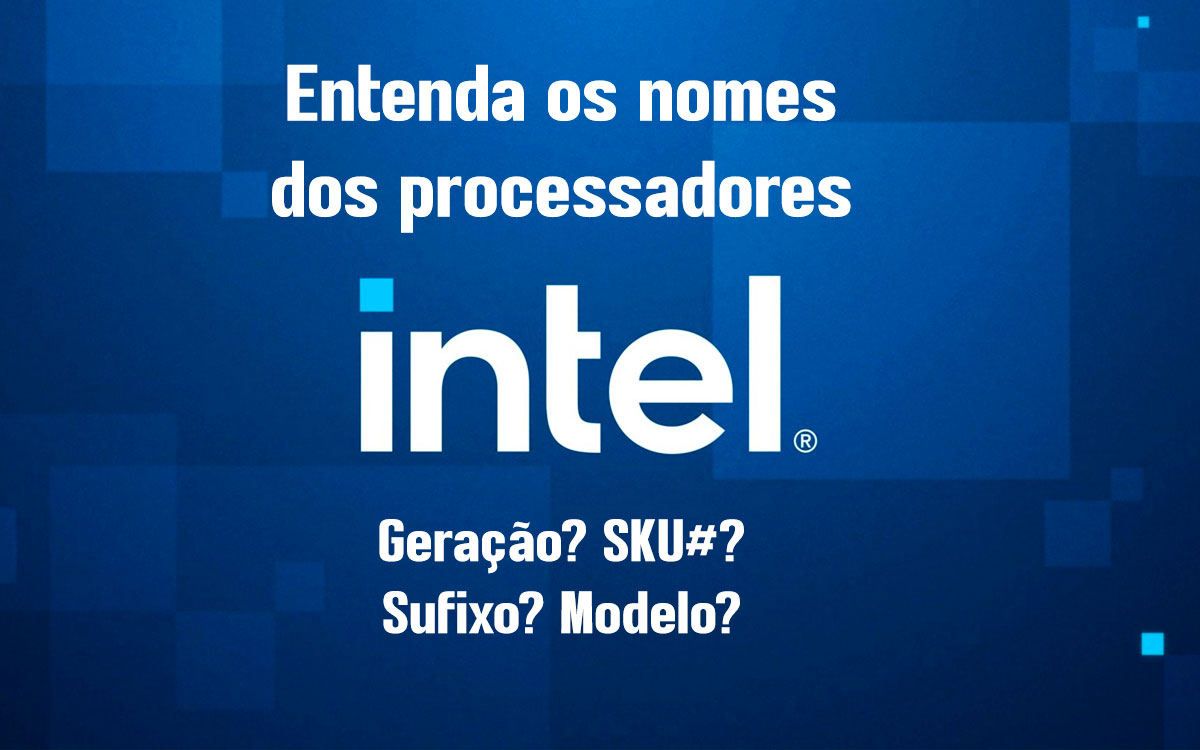
With the rebranding of processors and the arrival of Intel Core Ultrathe company presents a new way of naming its products. And with a large amount of nomenclature for models, generations, suffixes and families, understanding them all starts to become a complicated task.
In this article, you will understand the current names of processors in use by Intel, both for notebooks and desktops.
Intel Core i9-14900KS CPU Review: 14th Gen Elite
REVIEW | Intel Core i3-13100F – is the cheapest one still worth it?
REVIEW | Intel Core i3-13100: Raptor Lake news missing
Understanding nominal characteristics
With more than 300 models produced and owning more than 70% of the market shareIntel is the world’s leading manufacturer of processors for desktops, notebooks and mobiles. And as one of the giants in the hardware industry, naming the equally gigantic variety of processors with their other enormous variety of features requires a large amount of information to differentiate its products.
To achieve this, the company decided to create different names for its processors, in order to make it easier to identify what each one offers. However, with more than 10 years of production, more than a dozen different generations and models that accumulate a large number of differences, the company realized that it was time for a well-deserved rebranding.
But before understanding how the changes came about, let’s understand what Intel’s main product is named.
Intel Core ‘i’

Intel’s flagship product is the Intel Core ‘i’, which had its first generation launched in 2008 with the Nehalem microarchitecture. This line of CPUs has a range of functions ready to meet all audiences and the best way to recognize which product is ideal for you is by looking, obviously, at its nomenclature. Starting with:
Brand Qualifier/Performance Subdivision
- i3: Created as an entry-level product for users looking for computers that do not require large processing capabilities. Excellent for school computers, customer service. They have the lowest clock speed and number of cores than other qualifiers (the most recent ones reach up to 4 cores and 8 threads). Example: REVIEW | Intel Core i3-14100F – cheaper still has room?
- i5: Indicates the intermediate model of this line of processors that will serve computers that will deal with a greater demand for activities. Its capacities are greater, and can have up to 12 cores, which makes it a good cost-benefit processor. Example: REVIEW | Intel Core i5-14600K.
- i7: Here we recommend high-performance processors, excellent for activities that require greater processing capabilities, and can have 20 cores and 28 threads. Example: REVIEW | Intel Core i7-14700K – the direct competitor of the Ryzen 9 7900X.
- i9: Indicates the line of the brand’s most powerful processors, aiming to deliver great processing capabilities with the largest number of cores (24) and threads (32). Example: REVIEW | Intel Core i9-14900K is an improved version of the 13900K.
Processor generation and model/differentiator/SKU#
This is one of the main features to look out for when identifying the processor, as it will tell you about the processor’s generation. In other words, the higher the number indicated, the more up-to-date the CPU is, with its higher technological capabilities.
It is Intel’s custom to launch a new generation every year, bringing various improvements to the products, such as a greater number of cores and threads, improvements in cooling capacity and CPU power consumption.
Currently, processors are in the 14th generation, which creates a large list of products with very diverse prices and configurations to meet the most varied possibilities of use, ranging from simple daily use for writing school papers, to supporting computers performing complex calculations.

The following numbers are one of the ones that confuse buyers the most, as they represent which model the processor belongs to, and can have a variety of differentiators.
They can indicate the frequencies that will be delivered by the processor and the additional technologies that will come with the product, which may be security and/or CPU customization technologies.
A good example of how these numbers are indicative of a considerable change is the difference between the Core i9 13900HX and Core i9 13950HX processors:


In addition, the i9 13950HX also has a 0.10Ghz increase in frequencies, one of the features that will probably always come with these extra differentiating numbers.
Suffixes
Here the “alphabet soup” begins to thicken, as Intel has more than 20 suffixes to identify various features presented by its products. This is one of the pieces of information to pay attention to when purchasing one of its processors.
For desktops we have:
- K: Indicates processors with high processing performance, in addition to being unlocked for overclocks;
- F: Informs that it requires dedicated graphics;
- S: Identifies products that are special editions of the company, which can range from a limited edition to a prototype;
- T: For energy-optimized lifestyle, lower frequencies;
- X/VEHICLE: High performance and unlocked for overclocking.
For laptops:
- H: Aimed at notebooks with high processing performance and low energy consumption;
- HK/HX: It has high performance, all SKUs unlocked;
- P: Optimized performance for thin and light notebooks;
- U: Indicating that it is a processor with low energy consumption, being more used in ultra-thin notebooks;
- Y: Extremely low energy consumption;
- G(1-7): It shows that it is a processor with integrated graphics technology, the higher the number, the better the graphics capability.
On integrated GPUs:
- E: Informs that it is an integrated processor;
- UE: It has good energy consumption efficiency;
- RA: Delivers high performance;
- UL: Energy efficiency in LGA package;
- HL: Maximum performance, in LGA package;
What if he does not have any suffix at the endwhat does this mean? It depends, but most of the time it indicates that the processor has an integrated graphics card, which makes the product more expensive.
What changed in the names?
As previously mentioned, there was a rebranding of the company that retired the ‘Intel Core i’ and introduced two new lines of processors, the Intel Core Ultra and the new Intel Core. Both will have the same naming structure, which was one of the main changes that came to facilitate identification.
The company did not announce any changes to the model identifiers (suffixes and numbering), which will remain the same. The “i” and three numbers are gone, leaving the processor number with just three numbers and one to two letters.
Intel Core

The new Intel Core is an entry-level processor, aimed at notebooks that do not require high performance. They have only three modifiers: Core 3, 5 and 7, which perfectly meet daily uses for study, work and simple hobbies.

Intel Core Ultra

Already the Intel Core Ultra brings a product aimed at more advanced computers that, like the previous CPU, will also have three modifiers: 5, 7 and 9. The novelty here is that the processor will come excellently equipped with accelerated artificial intelligence, capable of assisting in audiovisual productions and other daily tasks.

The future of Intel processors
Intel has unveiled its full Raptor Lake Refresh CPU lineup at CES 2024. The series includes 18 new processors, ranging from the top-of-the-line Core i9 models to the entry-level versions. Further out, Intel plans to introduce the “Arrow Lake” (15th Gen) and “Lunar Lake” (16th Gen) processors in the second half of 2024.
Another highlight is Sierra Forest – Intel’s first E-Core processor with 288 cores per socket, which is set to launch in the first half of 2024. This chip is designed specifically for servers and is a direct response to AMD’s 128-core offering, known as Bergamo.
With these new processors, Intel aims to not only maintain its leadership position, but also define the future of high-performance computing. For consumers, this means access to cutting-edge technology that can transform the way we live, work and play.
14th Gen Intel Core: Is Meteor Lake Really a Revolution?
Intel XeSS: check out the GPUs that support the technology
Intel XMP: What it is and how to configure it
Source: https://www.adrenaline.com.br/intel/nomes-processadores-intel/


